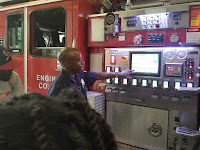South Grand Walk
 |
| Mokabe's Coffee shop on S. Grand Blvd. |
Tytianna Parrett
The second Neighborhood walk we took was in South St. Louis by Mokabe's Coffee shop. The area was nice and very diverse. Everyone was as nice to us as we were passing by. The places were so unified compared to some of the places I've been to in the North side. We really got a chance to see different cultures. There was so much love in the air.
The stores were so diverse with so many different options. The place that stood out to me was the Moroccan restaurant. As we passed by, a lady that worked there changes the sign from open to close. We also went into a frozen yogurt place that was actually pretty good. The time we spent walking really helped me see the different lifestyles.
The one place that I absolutely love was the pizza place called, “Pizza Head.” It looks like a comforting environment. The neighborhood was decorated in rainbow flags to support the LGBT community. I love being over in that area. After we left that part of Grand and went up the street (North Grand), it changed drastically. It was so much trash on the ground and liquor stores on every other corner. That was really shocking. The "hood walks" always surprise me.
****************************************








Darryeon Bishop
The
South Grand walk was very different from the Ville walk. What was different
from this neighborhood walk to the one around the Ville was there were a lot
more businesses and foot traffic going on. The stores and shops I saw, were ice
cream shops, coffee shops, sit down eatery places, book stores, yoga community
park, cleaners, international food stores and a lot of places. Also what I saw
was different people from cultural backgrounds walking the streets as well as
ethnic eating places. The type of housing in the neighborhood was single, brick,
two-family flats and also condo housing. I saw a community that support each
other and welcomes all walks of life to their neighborhood. This is what we
lack in North St. Louis and hopefully things will change for us to do the same
thing in our communities. I learned a lot from this walk and learned that if
the black community supports one another and their businesses, we can have
neighborhood stability in North St. Louis.
****************************************
************************************
The Ville
Darryeon Bishop/ 6-29-2017
The
walk through the Ville neighborhood was nice because I got to know what the
neighborhood was all about. We also made stops around the Ville and talked to
people who work and live in the neighborhood. First, we stopped by Emerson
school to talk to the people who worked there and also toured the school to
what they had to offer to their students. Most importantly, we learned that two
of the kids in the program go to this school which was interesting to know. I
was very happy to see an open and functional school in a north side neighborhood
where you hear most schools get closed down.
Second, we
stopped by north side community housing where they rehab vacant properties in
the neighborhood and build and beautify new homes for old and new residents. We
talked to Mona who works there and gave us information on what the north side
community housing was all about by telling us what’s their five year plan for
the neighborhood. Thirdly, we went by the old Homer G. Philip Hospital, now a
senior community home and learned a little history about how important this
hospital was to the neighborhood and the people who who came from this
community as well. Lastly, we stopped and toured the local fire station who
serves this community and got to know the fire-fighters and what it takes to be
one. The most interesting thing at the fire station was learning about the
computer system C.S.A.M. on the fire truck that sends pressure to the water hose
that the fire-fighters want to send. The idea came from a fire fighter right here in
St. Louis which makes it great and maybe can become a million dollar product.
The walk around the ville was great and I got to know and learn how important
this neighborhood was in the past and how we can remake its in the future.
**********************************************************
Trinity Tamara Wheeler
We
went on a neighborhood walk and I saw my school and it was pretty fun. We looked around the classrooms and we met some teacher’s there like Miss Johnson and Ms.E.Miss Marchell. Then we walked to the fire department. They
showed us around. The man took us around the fire truck and they had a hose fan
blower. Then we went to the Northside housing center and she talked about
how they fix houses and help people get them and with better
prices. We went to the nursing home and talked about how it's really old cause
that building was vacant for a long time. We came back and talked about the
things we did. I felt really good about the walk because its told me
something I didn’t know. I feel really great about this and hope we go on more
walks I will pay more attention so I can learn more about the neighborhoods.
**********************************************************
Devarayon Banks
The
Ville is a historic African- American neighborhood. The Ville has a long African-American history. It is still is mostly an African- American
neighborhood, and African-American people own the homes and businesses.
This
neighborhood has restaurants, like King Grill, Brother’s Diner, and Jaden’s
Diner. Homer G. Phillips Hospital is in the Ville, and it was the only hospital
for African-Americans from 1937 to 1955. Homer G. Hospital was one of the few
hospitals in the United States where black Americans could train as doctors and
nurses in the world.
 |
| The old Homer G. Phillips hospital site |
So,
the Ville was built by black people. Today the Ville is a low-income
neighborhood. The homes are old. The businesses built are old and need to be
rebuilt. The people of the Ville need to work together and stop killing each
other.
**********************************************************
Shontia Darling/ 6-29-2017
When
we walked around in North St. Louis we talked to some lady’s that work at
Emerson Academy. They teach kids from kindergarten to 12th grade.
The kids are in different classes based on their grade level. At the time of
our visit, the children were learning about Egypt and getting ready for a field
trip to the Art Museum.
We
then walked over to Homer G. Phillips Senior Community. It’s an affordable
living complex for elders. They house people that are 55 and older. It is
located in the historic “Ville” neighborhood of North St. Louis. Homer G.
Phillips was a prominent attorney in STL born in Sedalia, Mo. (1880- 1931).
Lastly,
we talked to Cpt. Chrunk and Mr. Eric Moorehead, two firefighters that’s a part
of St. Louis Fire Department. Cpt. Chrunk has been a firefighter for 32 going on
33 years. He is from North St. Louis. Mr. Moorehead is also a substitute
teacher. He has been a firefighter for 10 years.
**********************************************************
Tytianna Parrett/ 6-29-2017
The
first neighborhood walk we did was in the Ville neighborhood. It was insightful
and inspirational. The neighborhood looks like it’s in the process of being
rebuilt. We visited Emerson Academy. They are hosting a summer school program
on July 5th. Two of our new
students, Trinity and Gavin, are students there. They are doing so much with
the students. They take them on field trips after every session they learn. The
school teaches math, science, language, and social studies for students, k
through 12th grade.
We also visited the North side community housing office. That was very useful for me
because I’m currently looking for a place. They offered to me help in find a
home. We learned about the many plans that they have to recreate the North side
of St. Louis. We visited the Homer G. Phillips Senior Living complex. The
history of the building is absolutely amazing. So many good black doctors came
from the hospital.
The
firehouse was my favorite place that we visited. Capt. Chrunk gave us a lot of
information about what they do. Mr. Moorehead told us about everything that the
firefighters do, including where they sit. The fire station is the first to
have the Sam System. The system makes it easier for them to send water to the
different areas on the truck. They showed us the different types of hoses and
what they were used for. They left on an emergency call so we had to leave. The
hood walk taught me a lot about the area.


































